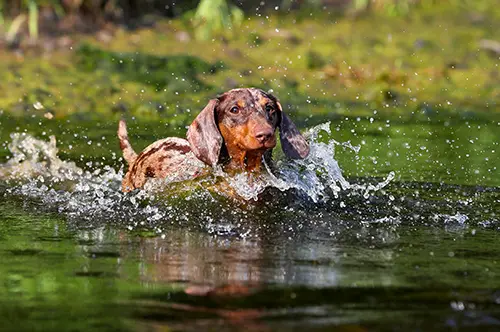
Lifesaving Swimming Safety Tips for Your Dog
This summer, take your dog swimming! Whether it’s a quick dip in the pool, a fun boat ride, or a splash in the creek, it’s a great way to keep your dog nice and cool from the heat.
But Wait! Before you let your pup dive in, you need to know these Lifesaving Swimming Safety Tips For Your Dog!
This page contains affiliate links and I earn a commission if you make a purchase through one of the links, at no cost to you. As an Amazon Associate, I earn from qualifying purchases.
Table of Contents
When my husband and I were first married, we had three dogs: Reno, Bastian, and Artemus. We always enjoyed walking our pups down the road to a small creek several times a week.
The dogs loved it! We have many fond memories of just letting the dogs splash and cool off on hot summer days. It was like taking them to their own personal doggie water park.
Water Safety Tips For Dogs
Help your dog love the water and stay safe too! Here’s how to keep your dog safe around the water.

Some Dogs Can’t Swim
Never assume that your dog can swim naturally when placed in the water. Some dogs can’t swim or float well at all.
Some dog breeds, including bulldogs, maltese, shih zu, and dachshunds may only be doing the doggy paddle for survival instead of enjoyment.
Dogs that have shorter legs and a large barrel chest may find it more difficult to float and paddle on their own for very long.
Watch Closely
Some dogs or even puppies have no fear and will jump right in the water by themselves (like my dog, Reno).
Always keep a close eye on your pup near any body of water. If your dog takes a quick dip, stay close and don’t look away. Your dog can sink underwater very quickly.
Note: Even the best canine swimmers can still have an accident in the water.
Floating Leash
Have your dog wear a floating dog leash while swimming in the water.
It’s brightly colored, so it is easy to see and you can pull your pup to safety if you need to do a quick rescue.
Some folks recommend taking your dog’s leash and collar off to avoid getting caught on debris while swimming.
Always keep your swimming dog right next to you so this can be avoided.
I would much rather have a floating leash or a life jacket handle to grab onto than nothing at all.

Getting Out Of The Water
It can be very difficult for your dog to exit the pool, lake, or pond by themselves. If it is too slippery or steep, your dog will need some extra help getting out of the water.
Practice exiting the water a few times with your dog to show them the way out and continue to remain close to your pup in case they struggle.
Mandatory Breaks
Swimming is a great exercise for dogs and humans, but it is tiring too. Dogs don’t understand how to preserve their energy while swimming.
You have to be the one to take them out of the water for a cool-down break, a fresh drink of water, and some time in the shade.
When my husband and I took our pups to a lake on vacation, every time we jumped in the water, they would too.
We noticed that they wouldn’t get out of the water until we did. Even though they were wearing their dog life jackets, we made sure we all got out of the water for a break to stay safe.
How Long Should Dogs Play In The Water?
Keep your pup’s swimming session short, 10 minutes maximum, then take a break.
Be Patient
Never force your dog to swim. Some dogs may need a more gradual introduction to the water. Allowing them to watch you enjoy the water may coax them in on their own.
If you force a scared dog into the water, it will create a bad experience.
Best Life Jacket For Dogs
Every year, we enjoy canoeing and kayaking at Pine Creek in Northern Pennsylvania. This past year, we read on their Facebook page that a large dog had fallen out of his family’s boat and was lost.
He was found several days later, but he didn’t make it. Come to find out, he wasn’t wearing a dog life jacket.
Pine Creek really isn’t that rough, it has one section of small rapids, but definitely not white water rapids. I felt very sad for the family, but I was also very concerned that they took their dog in a boat without a flotation device.
Accidents like this happen too often and can easily be prevented with a dog life jacket and an understanding of water safety for dogs.
Even if your pup is a super strong swimmer, all dogs should wear a life jacket in a boat or in the water.
Dog life jackets have a nice handle on the back so you can lift your pup in and out of a boat. This dog life jacket (From Amazon) is brightly colored, durable, and has some excellent reviews.
Heavy Weight
When dogs are wet, they are extra heavy! When you lift your dog out of the water into a boat or onto a dock, make sure the handle on the life jacket is strong and your back is ready for the heft.
My dog, Reno, (pictured below) is sporting his bright orange life jacket. He is the type of dog that will jump right in the water without permission. So, regardless of his sad puppy eyes, he wears his life jacket. Safety first Reno!

My German Shepherd, Artemus, in his bright orange dog life jacket. He really didn’t mind wearing it. He just wanted to be in the water, glued to his favorite person – my husband.

Moving Water
Avoid letting your dog swim in any type of moving water. Waves and strong currents are very dangerous for your dog.
Dogs that work extra hard at paddling can quickly over-exert themselves and sink.
Stick with shallow pools, lakes, creeks or ponds instead.
Fresh Drinking Water
Always provide plenty of cool water for your dog when you take a break from swimming.
Dogs lose a good amount of fluid through panting and they need to stay hydrated to stay cool.
Whether you are swimming, hiking, playing, or walking, always provide fresh water for your dog to keep them hydrated and safe. Keep this dog water bottle with you, it is super convenient and made just for dogs.
Don’t let your dog drink salty ocean water, lake water, or pool water.
Natural water sources, like lakes and ponds, can be contaminated. If your pup takes a drink, they may pick up some nasty bacteria or parasites and unfortunately, they can then pass them along to you.
Post You May Like: Nasty Parasites You Can Get From Your Dog.
Rinse Off After Swimming
Always rinse your dog off after swimming in any type of water. Pool chemicals, like chlorine, can cause your dog’s skin to dry out and itch.
After my three dogs would enjoy an afternoon at the creek, we would always rinse off their fur coats with clean water. This was usually done with the garden hose, as long as it wasn’t too cold.
How To Do CPR On A Dog
Learning how to perform CPR is an essential skill to know before your dog goes swimming. If your dog is unconscious, you need to know how to act fast to save their life.
Is Your Dog’s Airway Clear? It’s important to make sure the airway is clear before attempting CPR on a dog. Open your dog’s mouth and check their throat for obstructions.
Is Your Dog Breathing? Does your dog’s chest rise and fall? If you can’t tell, place your hand near the dog’s nose to feel for airflow. Also, check if you can feel a heartbeat.
Note: If your dog is breathing, CPR is not necessary.
Dog CPR Steps
1. Call Your Vet: Have someone call your dog’s vet if you find your dog isn’t responding while you begin dog CPR.
2. Mouth Placement: If you have a small dog (under 30 lbs), you should cover both the dog’s nose and the mouth with your own mouth. On larger dogs, only place your mouth over the nose, but try to prevent air from escaping through the dog’s mouth by using one hand to hold the mouth and jaw shut while giving breaths.
3. Artificial Respiration: Blow air into your dog’s nose and/or mouth (depending on their size). Enough air to cause your dog’s chest to rise. Then, release your lips so the air can escape. Try to produce 20 – 30 breaths per minute.
4. Chest Compressions: Lay your hand over the heart and press firmly enough to compress the chest about one-third to one-half its usual depth. Perform 10 – 12 compressions over a five-second span. Repeat these steps with one breath to 10 – 12 compressions ratio.
5. Breathing Check: Check to see if your dog has started breathing again every couple of minutes. If not, continue dog CPR.
Here is a YouTube Video from Sara Ondrako to teach you Canine CPR: What You Must Know.

Sunscreen For Dogs
While your pup is spending time around the water, they are at risk for painful sunburn.
Yep, dogs get sunburn too! Protect your fur-baby from painful sunburn with doggie sunscreen. Only use sunscreen that is formulated for dogs.
You can find some highly recommended dog sunscreens and sunscreen alternatives on our post: 5 Ways to Protect Your Dog From Sunburn.
Secondary Drowning
This is a scary one for people and dogs! If your dog inhales a bunch of water, goes unconscious, or sinks underwater – even if they seem ok afterward, they are at risk of secondary drowning.
When water is aspirated into their lungs, this can cause pneumonia, which can be fatal.
Note: The symptoms of secondary drowning (aka dry drowning) may not show up for hours or days after they inhaled the water into their lungs.
If you notice any of the following signs of secondary drowning, contact your dog’s vet ASAP.
- Hacking or Coughing
- Wheezing
- Difficulty Breathing
- Acting Lethargic
How To Teach Your Dog To Swim
Remember, many dogs don’t know how to swim by default. Your dog needs to learn how to swim first.
- Start with a small amount of water in a baby pool or very shallow creek
- Don’t rush, let them dip their paws in the water and get comfortable
- Get in the water with your pup
- As your dog gets more comfortable, try water that is a little deeper
- Lift your dog’s tummy or hid quarters while they swim to help them float
- Allow them to swim for a couple of minutes, then let them out
- Give them treats and make it a positive experience
Tip #1: According to AKC.org, you should start introducing your dog to the water at a young age. Keep the experience positive so they aren’t afraid of the water in the future.
Tip #2: Don’t let your dog swim right after eating. This can cause a dangerous disease called bloat.
Helpful Youtube Videos:

No matter how much your dog loves to be in the water, it is up to you to keep them safe with dog water safety.
What other dog water safety tips do you use? Let Us Know Below.






Leave A Comment